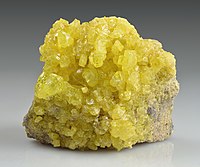
Photo from wikipedia
More than 60 million tons of sulfur are produced as a byproduct of the petrochemical industry annually. Recently, the inverse vulcanization process has transformed this excess sulfur into functional polymers… Click to show full abstract
More than 60 million tons of sulfur are produced as a byproduct of the petrochemical industry annually. Recently, the inverse vulcanization process has transformed this excess sulfur into functional polymers by stabilization with organic cross-linkers. These interesting new polymers have many potential applications covering diverse areas. However, there has been very little focus on the potential of these high-sulfur polymers for their antibacterial properties. These properties are examined here by exposing two common bacteria species, Escherichia coli (E. Coli) and Staphylococcus aureus (S. aureus), to two structurally different, inverse vulcanized sulfur polymers: sulfur-co-diisopropenyl benzene (S-DIB) and sulfur dicyclopentadiene (S-DCPD). We report the highest bacteria log reduction (>log 4.3) of adhered bacterial cells (S. aureus) to an inverse vulcanized sulfur polymer to date and investigate the potential pathways in which antibacterial activity may occur.
Journal Title: ACS Omega
Year Published: 2020
Link to full text (if available)
Share on Social Media: Sign Up to like & get
recommendations!